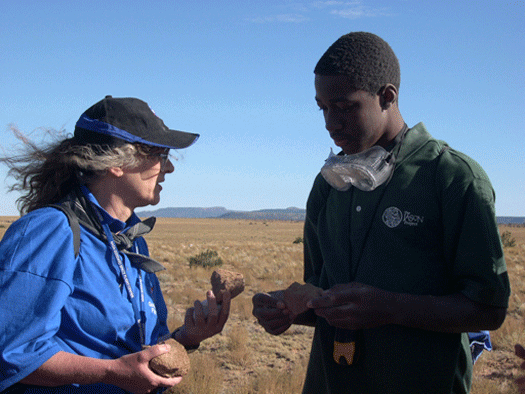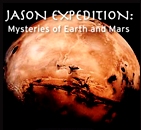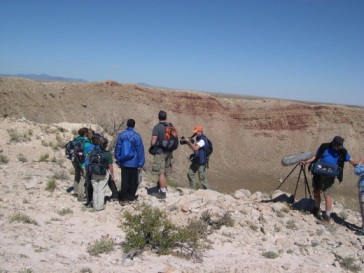 |
Dr. Pamela Clark, geoscientist for NASA Goddard Space Flight Center and Student Argonaut Chris Scarver examine shocked sandstone at Meteor Crater in Arizona as part of the JASON Expedition: Mysteries of Earth and Mars |
 |
How did you end up in the field you are in today?
I have wanted to work for the space program since I was ten years old. I was inspired by the landing of human crews on the Moon as part of the Apollo program. I particularly admired President Kennedy for making that commitment to landing 'a man on the moon' in less than a decade! What a challenge! How American to go into the dangerous frontier! I wanted to be a part of it. I couldn't imagine anything more exciting I could do with my life. I hoped to be the first woman that landed on Mars. Werner von Braun, German rocket engineer who surrendered to and joined the Allies after World War II, was also instrumental in starting the American space program for which I greatly admired him and I actually had a chance to meet him! He was responsible for involving a lot of young people in the space program by helping to create a NASA which has always heavily invested in educational outreach..... I ended up developing a career in Planetary Geoscience to be part of NASA.
What would you most like students to learn from participating in JASON Expedition: Mysteries of Earth and Mars?
I would like students to get excited about exploration and to see science as an important means of interacting with and learning to understand and expand out into the universe, finding resources we need along the way to make that possible. I would like students to have a chance to see what scientific work involves (hard work and dirt and frustration separated by moments of sheer joy, occasional terror, and serendipity encompassed by a sense of mission to probe the unknown). Field work is science on the ground, at its most obvious, based on first hand observations. I would also like to strengthen the creative problem-solving and team-building skills of participating students.
What advice would you give to students who are interested in studying science?
I would give them the same advice I would give other students, with one exception. I would offer special encouragement to pursue their goals with great dedication. Self-discipline and self-sacrifice and singlemindedness, less important values in today's American postmodern culture, are even more essential than they were before. Such values will allow students to compete more effectively with students entering technical fields from other parts of the world in a global economy. I would also encourage them to consider smaller colleges where they will get more hands on experience in science or engineering when it is time to think about colleges. Take advantage of every hands on experience you can get in your field of interest.
Why do you think it is important for students to make comparisons between Earth and Mars, and what can we hope to learn by doing that?
I explore the world around me in order to understand its amazing mystery. As they look closely at the world around them, the students will find the extraordinary, arresting and beautiful, close at hand. This is compellingly true for the world remote from us, deep within and outside of the earth. We go to the edge of the frontier, the solar system, for adventure, for insight, for novelty, for opportunity. I was always struck, from the time I was very little, with what a gift this world is, how we understand so little now, and how much more there is to explore and be grateful for. How can anyone stop exploring?
As far as Mars is concerned, Mars is a special case, the most Earthlike among the planets in many ways, and, as a result, the place where life is most likely to have arisen independently of the Earth. As we go looking for that possibility, Mars continues to evade us, to provide tantalizing evidence that Mars may or my not have had living things. So, very important questions scientists now and in the future will be asking are: Is there life on Mars? Are we alone in the universe (as living beings)? How will we recognize life? How will we protect it and protect ourselves from it? Did living things die out or survive on Mars? How did that happen? To answer these questions, we will need to look at changes recorded in Mars rock and atmosphere. Deposits on the ground and in the atmosphere would have changed in dramatic ways while living things existed on Mars. Mars is subject to extreme climatic shifts, so any survivors would have had to be able to tolerate 'extremes'. We are now in the process of exploring the adaptations of living things in analogous extreme environments on the Earth, including very dark, cold, or hot places deep in the oceans or underground. When we go to Mars, we will have to do field work in analogous places, poke into rugged terrain, look at the bottom of craters and pits, and icesheets, to answer those questions. The students could be participating in that activity some day!
 |
As a member of the basketball team, Chris recognizes the importance of teamwork. He also participates in Best Men, a community program that pairs young men with adult mentors. Last year, the group recognized Chris with an award for exceptional attendance and positive attitude.
 |
As an alternative to a wheeled rover, Dr. Allan Treiman, Planetary Geologist from the Lunar and Planetary Institute, TX, and student Argonaut Anna go over the operation of the TET prototype at Meteor Crater in Arizona as part of the JASON Expedition: Mysteries of Earth and Mars. It's a tetrahedral walker that tumbles to negotiate the rough landscape. Made up of six struts, it can be independently retracted or expanded telescopically, like the legs of a camera tripod. It moves by either shrinking or extending its edges to move its center of gravity beyond its base, so that it falls over. |
 |
Anna has participated in several extracurricular activities, including playing piano, being a Colonial Living History Apprentice, participation in Girl Scouts, Math Olympiad team, and the Reston Bible Church Youth group.
Page created on 7/3/2013 12:02:00 PM
Last edited 7/3/2013 12:02:00 PM

For over a decade JASON Expeditions have taken place around the globe.

2005's JASON Project expedition, “Mysteries of Earth and Mars,” explored several different locations around the United States. The student and teacher “Argonauts," along with a team of renowned researchers and scientists, helped "unravel the mysteries of Earth and Mars" as they compared the two planets through exciting scientific exploration!
Scientists know that Earth and Mars share a common origin in the solar system, yet are two planets which evolved very differently. By visiting locations on Earth whose environment could best be paralleled with that of Mars, and which, despite extreme conditions, have life forms thriving therein, the JASON team was able to theorize about the types of life that could potentially exist in the extreme conditions of 'the red planet' as well.

While at Meteor Crater, the students even got to work with a TET prototype, a tetrahedral walker that tumbles to negotiate the rough landscape. To top off an already amazing day, as it turned out, NASA's 'Desert Rats' team was also doing testing of its own in the Meteor Crater area that day, and the Argonauts were given a surprise ride, experiencing the latest design and technology for the next lunar (and perhaps, Martian?) vehicle, for themselves!